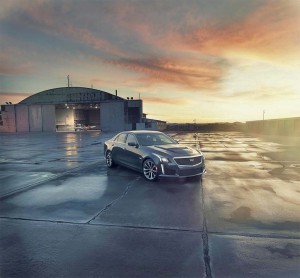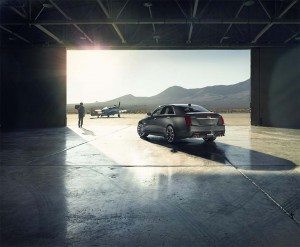Cadillac’s new 640-horsepower CTS-V will not only be the brand’s most powerful model ever, but also its most expensive sedan ever, at $84,990 including delivery charges.
The third-generation performance sedan is aimed at some of the luxury segment’s toughest competitors, including the vaunted BMW M5. But while it delivers more muscle than the Bavarian performance sedan it remains far from certain consumers will accept the hefty price tag which is about $11,000 more than the outgoing version of the Caddy CTS-V.
“V-Series represents the pinnacle of Cadillac, a brand that now makes drivers’ cars at the highest level,” said Johan de Nysschen, Cadillac president, in a statement. “The new CTS-V is essentially two cars in one: a luxury sedan with sophisticated road manners and a track-capable sports car with awe-inspiring performance.”
The first V-Series model, introduced in 2004, was a version of the original Cadillac CTS sedan and was rough and raw but meant to raise the brand’s awareness – and serve notice on German rivals like BMW, which had built a loyal following for its M performance models. A more sophisticated model of the CTS-V followed the launch of the second-generation sedan. Cadillac then added wagon and coupe versions.
(Cadillac confirms plan for plug-in version of new CT6 flagship sedan. Click Here for more.)
The latest, 2016 version comes to market more than a year after the launch of a completely redesigned Cadillac CTS sedan. Where the original was a “tweener,” sized between the BMW 3- and 5-Series models, the latest CTS grew larger to directly target the 5-Series.
And where the old CTS-V was powered by a 6.2-liter V-8 making 556-hp and 551 pound-feet of torque, the new model blasts 640 ponies and 630 lb-ft out of a similarly sized eight-banger. That’s enough to launch it from 0 to 60 in just 3.7 seconds.
The 2016 Cadillac CTS-V is more powerful than either the 5.5-liter twin-turbo V-8 in the Mercedes-Benz E63 AMG or the 4.4-liter TwinTurbo V-8 in the latest BMW M5.
(Caddy planning to drop or replace numerous current models, including XTS. Click Here for the story.)
The Detroit rocket also adds a number of sophisticated features such as magnet ride control, a suspension system that uses a magnetorheological fluid to constantly change damping at each corner to respond to both road conditions and driver input. It’s quick enough to go from full soft to track firm in the time it takes the performance sedan to travel just one inch at 60 mph.
Cadillac put a premium on lightweighting the new 2016 CTS-V with such features as a carbon fiber hood. The performance sedan also shows off its bright red Brembo brakes, and it is shod with new Michelin Pilot Super Sport tires.
The interior features a number of new refinements that, Cadillac officials claim, will make the CTS-V an everyday driver, not just a toy for the weekend.
But it all drives up the base price to $83,995 plus shipping.
Since joining Cadillac last year, the brand’s new global president Johan de Nysschen has been arguing that Caddy needs to price its products more in line with its German competitors and stop positioning itself as a bargain brand. That strategy may be working in the booming Chinese market but it has met with some tough resistance in the U.S. where sales slipped last year. Some price adjustments have helped Cadillac regain some momentum in 2015.
The 2016 CTS-V will come to market shortly after sales start for the second model in the Caddy V-Series line-up, the first-ever ATS-V which carries a price of $60,465 plus shipping.
As TheDetroitBureau.com recently reported, Cadillac is planning a major expansion of its performance line-up to coincide with the overall growth of its product portfolio over the next five years.
“The ‘V’ will be on more models than today,” said Dave Leone, Caddy’s chief engineer, though he cautioned that it will not land on every product in the Cadillac line-up. Don’t expect V-Series versions of the Escalade or SRX, he said.
(Click Here for more on Caddy’s plans for the V-Series.)



This is kind of a halo model for those who aren’t serious drivers and are more profilers.
Jorge, you’re speaking here without actual seat-time experience. I just drove the ATS-V at the Circuit of Americas — review soon to follow — and anyone who might think this car can’t stand up to the best European performance machine is the one who is a profiler unable to get past the badge. I’ve yet to drive the CTS-V, but if it matches up with the ATS-V it will be a serious contender for those who judge performance by driving dynamics and not the pedigree of the vehicle.
Paul A. Eisenstein
Publisher, TheDetroitBureau.com
Paul,
No disrespect but there is a lot more to driving than a few track laps at a press model review. It doesn’t matter to me what the badge on the car is, what matters is the engineering, performance, durability, etc.
Cadillac has done well in certain forms of motorsport in recent years and they are trying to use that success to hit a niche consumer market. A race car is very different from a street car however.
A vehicle can have great “numbers” and perform well and still be an also ran compared to the best of breed, which is what Cadillac is attempting to compete against. I guarantee that you won’t find many real drivers driving the V series.
Jorge,
I spent more time driving the ATS-V than just on CoTA. It is a dynamic, fun vehicle anywhere and anyway you drive it. It is more than up to the direct European competition and the only reason it may not sell more will be because too many drivers are unwilling to get out of the rigid mindset of what product is acceptable to be seen in. That’s been slowly changing: Audi is justifiably gaining ground here. The V-Series models should do similar things for Caddy. Any reason they don’t sell well will be due to perception problems, not product problems.
Paul E.
Sorry Paul but I respectfully disagree with you.
Cadillac has some excellent engineers (some of whom I know and have worked with personally) and they deliver a quality product – when management allows.
When Cadillac or Mercedes goes about designing a new model they have to prioritize the design based on many factors but primarily upon the expectations of the target audience. As such Cadillac’s (and Mercedes’)designs are based on luxury and comfort. Sportscar performance is not the top priority for these models. There in lies the issue with Cadillac competing with say BMW or Porsche in the performance “sporty car” sedan/coupe segment.
The engineers at Caddy can only do so much with the platform they are given to work with. Re-engineering it for more performance is possible but that doesn’t make it into the equivalent of a true sports car any more than installing a Porsche engine and Brembo brakes in a VW makes it into a Porsche. You might have a very nice VW that accelerates and stops well but the handling dynamics are still far from a Porsche or even a proper BMW because of the original chassis design priorities. BMW engineers almost came to a fist fight over a one millimeter change in the roof height on a new model… That’s how obsessed the engineers are with details. (Typical Germans. LOL)
When BMW or Porsche decide to build a sedan/coupe they start with the premise that it MUST handle like a quality sportscar as the number one priority. Then they go about adding the luxury and comfort after the basic handling premise has been achieved. This results in different driving experiences for the different market segments. They might both be fun to drive but only one is a true driver’s car, IME.
IMO one of the biggest reasons why the Caddy won’t sell all that well is it’s styling which is polarizing. You either like it or hate it. It certainly isn’t what most people would consider a pleasing curvaceous design as Caddy’s of the past were.
I’d love to have the opportunity to drive the new Caddy CTS-V. I currently drive a Mercedes CLK 55 AMG. Would be most willing to switch to an American car if it offers competitive performance. I wouldn’t go so far as to making any blanket judgement regarding any vehicle without having the ability to drive it. Thanks for your article.